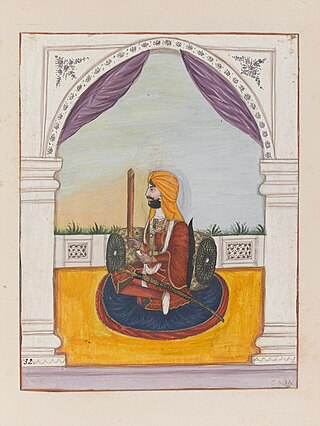Related Research Articles
Shiekh Baba Shadi Shaheed, or Raja Shadab Khan was a Sufi saint. He was the first Chib Rajput who married a Mughal Princess during the reign of Babur. He was a famed wise man who was requested to treat the ailing emperor, Babur, in Delhi. As a reward, Babur gave his daughter in marriage to him. He also married Humayun's niece who is the daughter of Pir Haibat, of Kandahar, which ultimately leads to his death during Akbar's reign. Raja Shadab Khan, was a contemporary and feudatory of the Emperors Babur, Humayun and Akbar; and he ruled over the districts of Bhimber, Mirpur and Nowshera, within the present limits of Jammu and Kashmir. In consideration of his services rendered to the Emperor Akbar in Kandahar, he was made Governor of Kashmir with the title of Shadab Khan. He also served as governor of Kandahar during Akbar's reign. His tribe, the Chib Rajputs of Kashmir and Punjab, come to his shrine in Jandi Chontra in Bhimber to pay their respects and ritualistically celebrate the births of their children. In the last few decades, the popularity of the shrine has grown among non-tribe members due to the belief that visiting the shrine will help childless couples to bear children.
Sadip Chand, adopted the Muhammadan faith in the Court of the Emperor Babur, and was confirmed by that monarch in his possessions, taking the name of Shadab Khan. This Chief accompanied the Emperor Humayun on many of his expeditions, and was at length killed in a quarrel.
The Sial or Siyal is a Punjabi Rajput & Jat tribe in the Punjab region of the Indian subcontinent, split between India and Pakistan.

The Majithia family, are a family of Shergill Jat sardars (chiefs) that originate from the region of Majitha in the Punjab.

The Battle of Jamrud was fought between the Emirate of Afghanistan under Emir Dost Mohammad Khan and the Sikh Empire under Maharaja Ranjit Singh on 30 April 1837. Afghan forces confronted the Sikh forces at Jamrud. The garrisoned army was able to hold off the Afghans till Sikh reinforcements arrived to relieve them.

Sir Lepel Henry Griffin, was a British administrator and diplomat during the British Raj period in India. He was also a writer.

Ranjodh Singh was a powerful member of the Sikh aristocracy and governor of Hazara. The Majithia family are Jat of the Shergill gotra (clan), and were particularly influential in the area near their headquarters in Majithia.

Sardar Muhammad Arif Nakai was a Punjabi politician from Pakistan and a former Chief Minister of Punjab.
Malik Saddu Khan or Sado Khan was a Pashtun figure, and the ancestor of the Sadduzai or Sadozai clan of the Abdali Pashtun tribe, to which belongs Ahmad Shah Abdali and some known families of Multan. He succeeded his father as chief of the Habibzai section of the tribe, but due to his "bravery and ability" he was selected by the Abdalis, then living between Kandahar and Herat, to be their overall leader in 1598.
Manawala is a city in Sheikhupura District, Punjab, Pakistan. It is situated on the Lahore-Sheikhupura-Faisalabad road.
Kunwar Tara Singh, sometimes styled as Shahzada was the younger of the twins of Maharaja Ranjit Singh, founder of Sikh Empire and his first wife Maharani Mehtab Kaur. His elder twin brother was Maharaja Sher Singh, who briefly became the ruler of the Sikh Empire from 1841 until his death in 1843.
Kunwar Ishar Singh was the son of Ranjit Singh, Maharaja of the Sikh Empire and his first wife Maharani Mehtab Kaur of the Kanhaiya Misl. Ishar Singh was the first son of Mehtab Kaur and the second son of Ranjit Singh, as his second wife Maharani Datar Kaur of the Nakai Misl gave birth to his first son and heir apparent in 1801.
Amar Singh Majithia was a soldier and administrator during the Sikh Empire. He was born in Maan clan of Jats.

Gurbaksh Singh Kanhaiya was the eldest son and heir of Jai Singh Kanhaiya, the chief of the Kanhaiya Misl. He was the father of Maharani Mehtab Kaur and thus, the father-in-law of Maharaja Ranjit Singh, the founder of the Sikh Empire.

Raja Surat Singh (1810–1881) was a Punjabi Jagirdar, a military officer in the Khalsa Army, and a member of the renowned Majithia family.
Sardar Kahan Singh Nakai was the sixth and the last chief of the Nakai Misl. He was the grandson of the famous Sikh chief, Ran Singh Nakai and Sardarni Karmo Kaur. His aunt, Maharani Datar Kaur was the wife of Maharaja Ranjit Singh, founder of the Sikh Empire; thus making him the nephew of the Sher-e-Punjab. From an early age he assisted his father in campaigns and even commanded campaigns assigned to him by his uncle, Maharaja Ranjit Singh. His cousin, Kharak Singh went to become the second Maharaja of the Sikh Empire. He was the uncle of the third Maharaja, Nau Nihal Singh.
Mian Ghaus Khan, also known as Mian Ghausa, was a Punjabi Muslim of Arain descent who served as an artillery officer of the Sukerchakia Misl under Sardar Maha Singh. After Maha Singh's death, Ghaus Khan served his son, Ranjit Singh, the founder of the Sikh Empire. Ghaus Khan's son, Sultan Mahmud Khan and grandson, Sultan Ahmad Ali Khan, too served in the Sikh Khalsa Army.
Sultan Mahmud Khan was a commander of the Sikh Khalsa Army, the army of Sarkar e Khalsa. His derah of artillery was designated as Topkhana Sultan Mahmud. He is regarded as one of the best commanding officers of Maharaja Ranjit Singh.
In 1820, Yousafzai once again revolted against the Sikh Empire, which led to the Battle of Gandgarh. Hazara was under Diwan Ram Singh with thousands of well-equipped soldiers; on the other hand, Yousafzai tribesmen were local zamindars. Yousafzai Afghans killed the governor of Hazara, Diwan Ram Daya.
In 1832, the Sikh Empire launched an expedition against the small mud fort of Malik Dilasa Khan, whose name was a "terror to the Sikhs" and who had beaten from his mud fort Tara Chand, the bravest Sikh general.

Sial dynasty was a chieftaincy that ruled over the Sial state (c.1727–1818) in central Punjab during 18th century. It was centred in Jhang.
References
- ↑ Sir Lepel Henry Griffin (1890). The Panjab chiefs: historical and biographical notices of the principal families in the Lahore and Rawalpindi divisions of the Panjab. pp. 74–. Retrieved 17 April 2012.
![]() This article incorporates text from this source, which is in the public domain :The Panjab Chiefs: historical and biographical notices of the principal families in the Lahore and Rawalpindi divisions of the Panjab, by Sir Lepel Henry Griffin (1905)
This article incorporates text from this source, which is in the public domain :The Panjab Chiefs: historical and biographical notices of the principal families in the Lahore and Rawalpindi divisions of the Panjab, by Sir Lepel Henry Griffin (1905)
This article needs additional or more specific categories .(August 2023) |